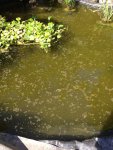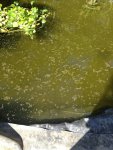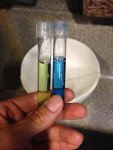Hello,
My 2200 gall pond is officially one month old. I live in the Cayman Islands, its hot and sunny all the time. The pond is always partially shaded,= and about 1/3 is covered in water hyacinths. I don't have a water testing kit yet, because I live on a small island and the one pet shop is out of them. The last time I had the water tested at the store, everything was in normal levels. I think the pond is healthy, I have a few baby fish already and yesterday when I cleaned the filter I found blood worms (which scared me at first, but after a quick google, it seems they are fine and found in healthy ponds).
For the last few days my pond has little bits of something floating on it, they disappear overnight and reappear around lunch time.
Right now I am using a waterfall filter, which has the very stiff white filter and lots of quilt batting. It had been working great, until today. The pond is quite green. I wouldn't call it pea soup yet, but its getting harder to see the bottom.
I do have a large UV filter, but unfortunately the hardware store is out of the size hosing I need to hook it up, so I'm just waiting. I called the pet store, they have one package of the barley (for 1200 gall pond, my pond is 2200 gall).
Will this phase pass? Do I need to hook up the UV filter with some how using a smaller hose? Should I get the one bit of barley and see if it helps? Help!
Thanks for your thoughts,
Priscilla
My 2200 gall pond is officially one month old. I live in the Cayman Islands, its hot and sunny all the time. The pond is always partially shaded,= and about 1/3 is covered in water hyacinths. I don't have a water testing kit yet, because I live on a small island and the one pet shop is out of them. The last time I had the water tested at the store, everything was in normal levels. I think the pond is healthy, I have a few baby fish already and yesterday when I cleaned the filter I found blood worms (which scared me at first, but after a quick google, it seems they are fine and found in healthy ponds).
For the last few days my pond has little bits of something floating on it, they disappear overnight and reappear around lunch time.
Right now I am using a waterfall filter, which has the very stiff white filter and lots of quilt batting. It had been working great, until today. The pond is quite green. I wouldn't call it pea soup yet, but its getting harder to see the bottom.
I do have a large UV filter, but unfortunately the hardware store is out of the size hosing I need to hook it up, so I'm just waiting. I called the pet store, they have one package of the barley (for 1200 gall pond, my pond is 2200 gall).
Will this phase pass? Do I need to hook up the UV filter with some how using a smaller hose? Should I get the one bit of barley and see if it helps? Help!
Thanks for your thoughts,
Priscilla





